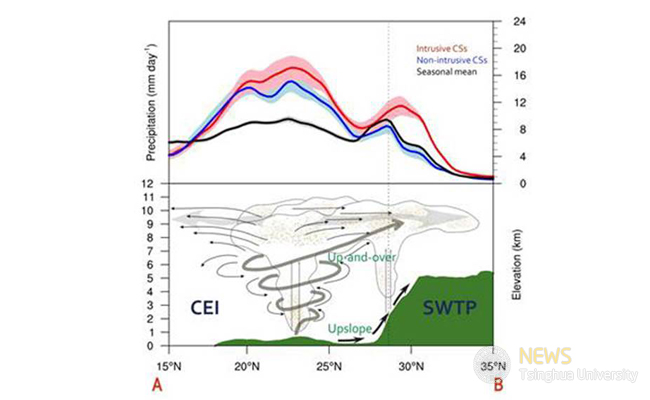A new moisture transport route into the Southwestern Tibetan Plateau
It revealed that deep convections over the Indian subcontinent drive and supply moisture source for summer rainfall over this region
Although far away from the oceans and isolated by the big Himalayas, summer rainfall reaches 300 mm over the Southwestern Tibetan Plateau (SWTP). By contrast, there are deserts over Arizona in the U.S. and Chile in the south America although they are not as far away from the ocean as SWTP and blocked by lower mountain ranges. Why?
On 7 March 11, 2016, Dong Wenhao, a Ph.d student of associate professor Lin Yanluan at Center for Earth System Science, Tsinghua University, published a paper “Summer rainfall over the southwestern Tibetan Plateau controlled by deep convection over the Indian subcontinent” on Nature Communications. The study found deep convections over the Indian subcontinent provide most of the moisture for the summer rainfall over the SWTP. This implies that the future variation of deep convection associated with Indian monsoon will impact summer rainfall over the Tibetan Plateau, and influence the glacier growth and retreat there in the future.

Figure above shows the two moisture transport routes and their associated rainfall contribution: the newly revealed up-and-over path contributes to most of the summer rainfall while the contribution by the conventional upslope path is relatively small. This phenomenon has been noted by the local people for a long time, as shown by a picture below, showing the precipitating clouds progressing into the plateau from south.

Both observations and global climate simulations suggest highly coherent connections between the summer rainfall over the Indian subcontinent and that over the SWTP, at both seasonal and event scales. However, such a close connection can not be sustained by the conventional upslope transport since it is very limited due to the high Himalayas. High resolution satellite measurements indicate this connection is actually maintained by an up-and-over route, i.e., moisture and hydrometeors are uplifted over the Indian subcontinent and Himalaya foothills by deep convections first, then they are swept over the mountain range and into the SWTP by the mid-tropospheric southwesterly. This finding is also supported by O18 measurements, backward trajectory calculations and a series of WRF sensitivity experiments. The lone term statistics suggests that more than half of the summer rainfall over the SWTP is directly related to this transport. Indian monsoon precipitation is projected to increase in the future by global climate models. Consequently, the SWTP probably will become wetter in the future with fundamental influences on the local glacier mass balance and ecology.
The study is a collaboration among several researchers in the center, Yi Ming from Princeton University, and Lide Tian and Lei Wang from Institute of Tibetan Plateau Research, Chinese Academy of Sciences.
The paper can be accessed at the following link:http://www.nature.com/ncomms/2016/160307/ncomms10925/full/ncomms10925.html
Dong, W. et al. Summer rainfall over the southwestern Tibetan Plateau controlled by deep convection over the Indian subcontinent. Nat. Commun. 7:10925 doi: 10.1038/ncomms10925 (2016).
(Edited by Shiyu)

